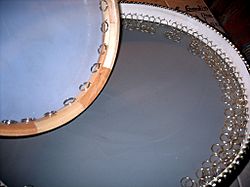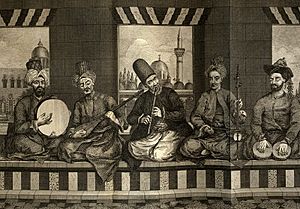Daf facts for kids
 |
|
| Percussion instrument | |
|---|---|
| Other names | dafli, dap, def, tef, defi, gaval, duf, duff, dof |
| Classification | Directly struck membranophones |
| Hornbostel–Sachs classification | 211.311 (Handle-less frame drum with one usable membrane) |
| Playing range | |
| High sound of jingles, plus some have a skin with a lower sound. | |
| Related instruments | |
| buben, tambourine, kanjira, frame drum, parai | |
The Daf (Persian: دف), also called Dâyere or Riq, is an ancient musical instrument. It's a type of frame drum from the Middle East, especially Iran. People play the Daf in both popular and classical music. You can find it in many countries, including Afghanistan, Azerbaijan, Tajikistan, Uzbekistan, Georgia, Pakistan, India, and parts of Russia. It's also loved by people in the Balkans, among Kurds, and in Macedonia.
The Daf is the national musical instrument of Pakistan. It even appears on the Azerbaijani 1 qəpik coin and 1 manat banknote.
This drum usually has a round wooden frame. It also has jingles, which are like small cymbals. The drumhead is often made from fish or goat skin. Newer Dafs might use synthetic materials. To play it, you hit the drumhead with your hands. Your left hand holds the Daf and strikes the edges. Your right hand hits the center. You can also snap your fingers on the drum for sharp, quick sounds.
History of the Daf Drum
The ancient Iranian name for the Daf was dap. Pictures of the Daf have been found in paintings from before the Common Era. This shows that the Daf is a very old instrument. It was used long before Islam became widespread.
The Daf played an important role in ancient Iranian music. This music was often used for spiritual purposes. For example, the Daf was important during the Sassanian period in Iran. There are even carvings of square frame drums at Taq-e Bostan, an old monument. These drums were played in the ancient Middle East, Greece, and Rome. They came to medieval Europe through Islamic culture.
The Daf was often played during Nowruz, the Iranian New Year, and other celebrations. This happened during the Sassanid Empire (224 AD–651 AD). During this time, the Daf was used to play traditional Iranian classical music. This music was created by a famous musician named Barbod the Great. Many of these old melodies are still known today. Dafs can create complex and powerful rhythms. These rhythms can make people feel very spiritual. Because of this, the Daf has always been connected to religion in Iran.

An old bronze cup from Lorestān shows a Daf being played with other instruments. This suggests that large groups of musicians played together in ancient times.
The Arabs brought the Daf to Spain. From there, it spread to other parts of medieval Europe. In the 15th century, the Daf was mainly used in Sufi ceremonies. Later, in the 17th century, the Ottomans helped bring it back to Europe.
Today, the Daf is still a very important part of Iranian music. It helps keep ancient musical traditions alive. Many young Iranians are learning to play this historic instrument.
The Daf, and a smaller version called dafli, are also used in India. They likely arrived during the medieval era with other Persian influences. The Daf is a popular folk instrument there. In southern India, it became popular in protests in the early 1900s. Since the 1950s, it has also been used a lot in Bollywood movies.
Daf in Islamic Culture
In Islam, the Daf is very important. Some Muslims believe it is the only musical instrument allowed. The Prophet of Islam, Muhammad, did not forbid using the Daf. Because of this, it has always been a key part of Islamic Sufi music.
How a Daf is Made
The Daf has a round wooden frame. Sometimes, modern Dafs use metal frames. Thin metal plates or rings, called jingles, are attached to the frame. These jingles are usually in three or four rectangular holes.
The drumhead is made from fish or goat skin. The frame is usually about 45–50 centimeters (18–20 inches) wide. It is about 5–7 centimeters (2–3 inches) deep. To make the frame, wood is softened in water. Then, it is bent around a hot metal cylinder. The ends of the frame are glued together to make a circle. Finally, the skin is attached to the frame. This can be done with another wooden frame or with nails. Some Dafs have jingles all around the inside edge. Others have several rows of jingles on one side.

See also
 In Spanish: Daf para niños
In Spanish: Daf para niños
- Tar (drum)
- Bodhrán
- Bendir
- Mazhar
- Davul
- Innaby, Azerbaijani dance



